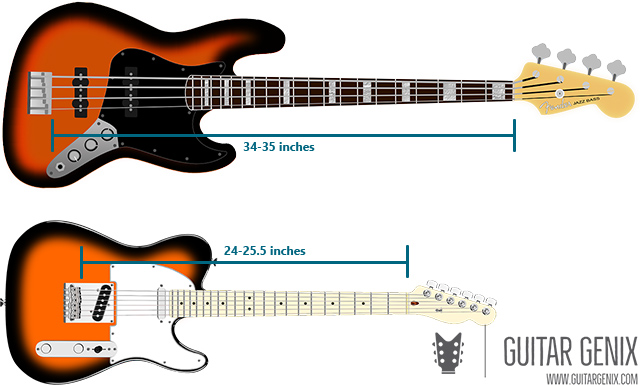Though the similarities, bass and standard guitars are different instruments with many differences. Bass guitars have thicker strings and are generally fewer in number (usually four), the neck and scale length is longer, and the tuning is different.
Regardless, since the strings, by and large, look similar, you might wonder if you can put bass strings on an electric or acoustic guitar. Will doing so transform an electric guitar into a bass? Would putting bass strings on an acoustic change the way they sound?
Let me first answer the question in short, and then we’ll get into further details since the answer is not that clear-cut.
It is not possible to put bass strings on an electric or acoustic guitar without making changes to several of its components. Changes that are irreversible unless you replace the part in question. For example, the slotting in the nut has to be widened to accommodate the thicker strings. The same goes for the bridge. Apart from that, the scale length and the string tuning do not match, and the resulting sound would, in most cases, be totally off.
Bass guitars have different construction than standard electric guitars (which they mostly resemble). The nut, bridge, neck, tuning pegs — everything is slightly different. Let’s now look at all the issues you might face while trying to put on bass strings on a guitar.
The Scale and Neck Length is Different in Bass and Standard Guitars

The Scale length, which is the strings’ length from the nut to the bridge, and the guitar’s neck is much longer in basses. Scale length usually being 34–35 inches in standard bass and around 32 inches in short-scale bass. Electric and acoustic guitars have a much shorter scale length at around 25 inches.
Effects on Tone
Frets on guitar are not some random division of the fretboard. They use complex calculations for this division, which considers the string specifically made for that scale length. Since the scale length differs significantly between bass and standard guitars, the division would be wrong. Thus the specific notes that are supposed to be produced from certain frets would no longer be correct. This issue would make the entire length of the fretboard sound pretty off, for the most part.
The Tension of The Strings is Different in Bass and Standard Guitars
You can put bass strings on a standard guitar in two different ways.
First is, putting them on with the same (one octave lower) tuning of bass guitars. This arrangement would be useful when somebody is trying to mimic the sound of a bass with a standard guitar. Since bass guitars are tuned lower but have a lot longer scale length, they are under similar tension as acoustic guitar strings (but higher than electric guitars).
Putting such strings on a smaller scale length acoustic in their original tuning would make them floppy and might even be unplayable. As for electric guitars, due to the thinner strings, they are built to withstand a lower amount of tension across the nut and bridge, and bass strings might put them under more tension. They might not break but may deform the neck, which is constantly under such pressure.
The second way is to put bass strings on a regular guitar with guitar tuning, in which case, owing to the higher gauge, the various components, including the neck and bridge, would be under a lot more tension that it would probably tear the neck or the bridge off.
So, whether you’re trying to use bass strings on an acoustic or electric guitar with standard or bass tuning, it might not only be unplayable but also break your guitar or its components.
You’ll Have to Modify Many Components of your Guitar
Bass strings are significantly thicker, the thickest low E string being around two-and-a-half times thicker than an electric guitar string, poses a lot of issues with the various parts and components of the guitar.
Starting from the tuning pegs that might not have holes big enough, you might have to get new tuners or try to make the holes bigger, a very easy way to damage the guitar, in my opinion.
Then comes the nut, which has slots that are made for far less thick strings. To put on the thicker bass strings, you’ll either have to fit another nut or shave and scrape the nut to make the slots bigger.
Then comes the bridge, which has the same issue because of the slotting but much worse because they are not only harder to change but also more expensive. Even the retention holes might not be able to fit the thicker strings.
Making all of these changes is not worthwhile, in my opinion, unless you have a cheap or mostly useless guitar, along with lots of free time and the experimentation mindset, in which case I would encourage doing this! For everybody else trying to make a quick bass out of their only guitar — you know my answer.
The Action is Different in Bass and Standard Guitars
The action is the height of the string above the fretboard, also called string action. Too high an action makes it harder to push the strings down on the fretboard, which makes it harder to fret, strum, and change chords. Too low, and a buzzing sound from the string hitting the frets would make the overall sound output very unpleasant. The trick is to set the action at the lowest height possible without causing any buzz.
Since bass strings are thicker, with the same guitar setup as regular strings, they would come closer to the fretboard, causing buzzing. So, if you were able to put on bass strings successfully, you’d still have to increase the action height by adjusting the truss rod.
Sound of Bass Strings on a Standard Guitar
If you are thinking of mimicking the sound of a bass guitar with your electric guitar, supposing you went ahead with all the adjustments and got lucky that it didn’t snap or deform with the added tension, you might get a bass-like sound out of it. However, the notes on the frets would be off, so the overall tone would not feel right. You might have to do a lot of tweaking with the amp or pedals to get something decent of it, which in the best case, wouldn’t still be much pleasant.
On the other hand, if you’re trying this out with your acoustic guitar, the strings in bass guitar tuning would be floppy and may have humming and buzzing. In many cases, the guitar would be unplayable. If, however, you try to tune these thicker strings to standard guitar tuning, you would either snap the neck or have the bridge come apart. If you want bass strings for their thickness, just get thicker guitar strings (still, the thickest of the strings wouldn’t nearly be as thick as bass strings).
Final Thoughts
Trying to make one instrument sound like another is a quest that might go hopelessly bad for a number of reasons mentioned in this article. Many electric guitar players, especially beginners, want to try out a bass when they hear it being played and wonder — if they can put bass strings on their guitar to make it sound like a bass. The thought itself is a valid one. After all, they are both similar-looking instruments.
However, as we have learned, there are a lot of dissimilarities that make this adjustment difficult. Furthermore, the end result might not be what you have in mind. If you’re mesmerized by the sound of a bass (who wouldn’t!) but do not want to invest a lot of money, why not try buying a used one? Or perhaps borrow one from someone you know? Until you can save enough to buy your dream bass, good luck!


